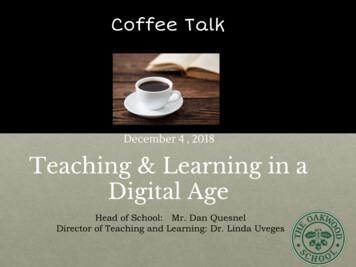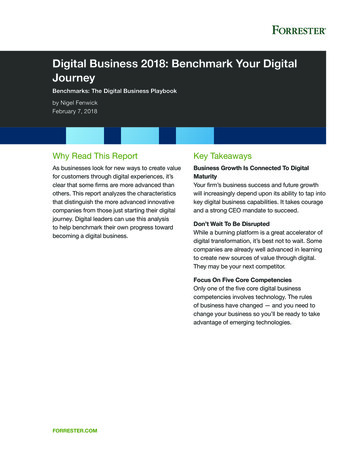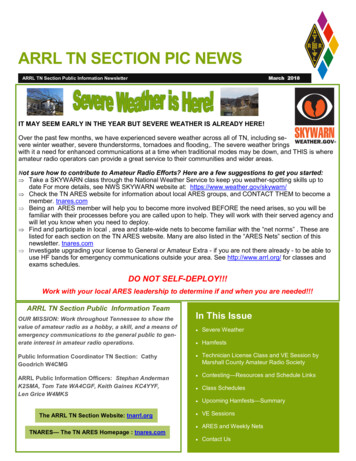
Transcription
Coffee TalkDecember 4 , 2018Teaching & Learning in aDigital AgeHead of School: Mr. Dan QuesnelDirector of Teaching and Learning: Dr. Linda Uveges
IntroductionPurpose of the Coffee Talks- Parent Education- Question/Answer Session- Getting to know those on campusFuture Topics- January 23- April 17: Transition from Lower School to Middle SchoolCommunity Education Resource Page- Recap- Educational Resources- Links, Books, Articles- Agenda
Website:Website
We are a Process SchoolRecap of Coffee Talk Presentations thus far:Coffee Talk #1 - Visible Learning* John HattieCoffee Talk #2 - Transformational Learning* Sir Ken RobinsonCoffee Talk #3 - Growth Mindset* Carol Dweck and Angela DuckworthCoffee Talk #4 - Teaching & Learning in a Digital AgeTie in of Growth Mindset, Passion and Perseverance andStudent Success
This month’s choice is.
Digital LiteracyIan Jukes
Ian JukesFounder and executive director of the InfoSavvyGroup - an international educational leadershipconsulting firm.He’s been a teacher, school principal, district andprovincial coordinator, writer, internationalconsultant, university instructor, and keynotespeaker.He’s worked with schools in more than eightycountries and made more than 10,000presentations.
Marc Prensky
The World Needs a New CurriculumIt’s time to lose the “proxies,” and gobeyond “21st Century Skills” - and getall students in the world to the real coreof education. Marc Prensky
Marc Prensky is an award-winning, internationally-acclaimed speaker, author, and “practical visionary” in the fieldof education. He is the founder and currently Executive Director of The Global Future Education Foundation andInstitute.Marc has spoken in over 40 countries, authored seven books, and published over 100 essays; his writing has beentranslated into 11 languages. Marc’s latest book, Education to Better Their World: Unleashing the Power of 21stCentury Kids (Columbia TC Press, 2016), won the FOREWORD INDIES 2016 Book of the Year Award Gold Prize forEducation.Marc’s background includes teaching at all levels — elementary through college, six years at the BostonConsulting Group, and 10 years as founder and CEO of a software game development company. He has been aprofessional musician and has acted on Broadway. He holds degrees from Oberlin College, Middlebury College,Yale University, and the Harvard Business School.
What’s wrong with kids today? For the digital generations, the past is aforeign country Larry Zimmerman- (adapted from Ian Jukes)Digital Natives.1:00-4:00
Our Focus:1. Reason for the title of the coffee talkTeaching and Learning in a Digital Age2. Research on Digital Generation3. Concerns/Implications4. Role in Education5. Shift to Digital Leadership
The Technological Alteration of the ModernMindA number of books have been written about theimpact of technology on digital culture.iBrain: Surviving the Technological Alteration of theModern Mind by Gary Small and Gigi Vorgan (2008)Brain Rules: 12 Principles for Surviving and Thrivingat Work, Home and School by John Medina (2008)
Piaget19th Century Swiss psychologist Jean Piaget madeobservations well over one hundred years agoabout children’s cognitive development.His comments have been useful in understandingwhat is going on inside children’s brains as they age.However, the rapid evolution of the brain that isoccurring today, particularly in light of theemergence of the new digital landscape, is causingresearchers to re-examine some of Piaget’sobservations about early cognitive development.
This morning EduWeek’s findings regarding theshift in Learning Styles
Concerns: “Without enough face-to-face interpersonal stimulation, achild’s neural circuits can atrophy, and the brain may notdevelop normal interactive social skills” (Small and Vorgan) Negative effects on several areas of development Not enough physical exercise Lack of appreciation for nature and being in the outdoors Not enough reading for pleasure- or at all Highly addictive nature of computer games and onlineadventure sites and the interactive nature of most digitalactivities are creating such obsessive behavior in kids that itmeets the definition of a clinical addictions.
The need for balance .There is a serious lack of balance in the lives of kidstodayThey need to balance multi-tasking skills withstrategies for developing single-tasking skillsThey must cultivate their ability to focus andcomplete one task at a timeThe same balance with adults- we need to balanceour nondigital life experiences with new digitalexperiences
In the book Understanding the Digital Generation,Ian Jukes makes the observation that whileexternally kids look the same as previousgenerations, they are neurologically differentbecause of digital bombardment - the inescapableexposure to digital technologies.
Brain Rules: John Medina, 2008Every student’s brain.is wired differently. That’s theBrain Rule. You can either accede to it or ignore it. Thecurrent system of education chooses the latter, to ourdetriment. It needs to be torn down and newlyenvisioned, in a Manhattan Project-size commitment toindividualizing instruction. We might, among otherthings, dismantle altogether grade structures based onage.
Marc Prensky
Digital BombardmentDigital bombardment - the inescapable exposure todigital technologiesHas created the “always on” generationAccording to Viacom Nickelodeon report, in the USbetween birth and age six, kids look at one or morescreens for an hour and twenty minutes a day. Thesemeasurements don’t even address indirect exposure toscreens which puts the amount of time a screen is on inthe foreground or background at nearly four hours aday for kids ages eight months to eight years.
Three Screen LifestyleThis includes any combination of TV, computer,tablet, and cellphoneThey’re using these different devices to build verycomplex and deep modes of communication withone another the “always on” generation.
According to the National Association ofState Boards of EducationOn average, kids today spend more than 80 hours a weekusing one, two, or more screens simultaneously - as opposedto about 25 hours a week they spend attending school.As a result, they spend more than 3 times the amount of timethey spend at school using their digital devices.Teenagers----to screenagersOf those 80 hours a week, they spend an average of 35hours online.10% of those spend more than one hundred hours a week.
An example:Video is becoming the preferred channel ofcommunication.2012 - internet video accounted for 40% of allinternet traffic2016 - 62%Every 60 seconds: 24 hours a day, more than500,000 videos are being viewed on You Tube 5 billion views or almost 2 trillion playbacks in the2016.
Two trillion playbacks 170 video views for everyperson on the planet.The amount of video being uploaded: every minute ofevery day, 24 hours a day, 365 days a year, 100 hours ofnew videos are uploaded. That’s 4 days worth of videouploaded every minute, 24 hours a day.Every minute: viewers are another 4 days behind intheir viewing.Consider that 100 hours a minute is almost 6,500 yearsof content uploaded every year.
How bad can it be?A Cisco survey of teens reports that one in threeindicate that the internet is as important as air,shelter, food, and water sources.Meanwhile 60% of those surveyed in China andBrazil believe that the internet is more importantthan air, shelter, food, and water sources (Cisco,2012)
why?danah boyd [ she does not capitalize her name](2014) wrote It’s ComplicatedWhat appears from the outside to be an addiction totechnology is in fact addiction to friendshipfriendship that is a hybrid mix of online andface-to-face interactions.The digital generations view the technologies assimply the portals to this friendship
F.O.M.O. and A.O.A.D.D.Fear of Missing OutAccording to Larry Rosen (2010) three quarters of teens andyoung adults check their devices every fifteen minutes orless, and if not allowed to do so, they become highly anxious.As a result, suffer from AOADD Always On AttentionDeficit DisorderFast-food mentality, expectation for instant access, instantgratification, instant feedback,instant recognition, instantsuccess, and instant change.“The death of patience”
Because of chronic digital bombardment, the digitalgenerations have had a great deal more experienceprocessing information at a far faster rate than wehave.They are better at dealing with high-speedinformation than older generations are.They have fast-twitch wiring
“Social Media Sitters”
Imagine students as they leave the outside worldand enter the classroom. Outside of school, they’reinteracting with friends, using social media onsmartphones and ipads, listening to playlists ofmusic that they’ve downloaded from the internet,or making and sharing videos on You Tube.Meanwhile, at school, they get to carry aroundheavy backpacks of books and listen to teachersreading off the board and talking at them while theytake notes using a pen and paper.They’re in the 21st Century when they are at home and the20th Century at school
Father Stanley Bezuska of Boston College provided several examples from throughout history of the struggle tounderstand and integrate new technologies into education as told in David Thornburg’s (1992) book Edutrends2010: Restructuring, Technology, and the Future of Education:At a teacher’s conference in 1703, it was reported that students could no longer prepare barkto calculate problems. They depended instead on expensive slates. What would students dowhen the slates were dropped and broken?In 1815, it was reported at a principals’ meeting that students depended too much on paperand no longer knew how to write on a slate without getting dust all over themselves. Whatwould happen when they ran out of paper?The National Association of Teachers reported in 1907 that students depended too much onink and no longer knew how to use a knife to sharpen a pencil.According to the Rural American Teacher in 1928, students depended too much onstore-bought ink. They did not know how to make their own. They wouldn’t be able towrite until their next trip to the settlement.In 1950, it was observed that ballpoint pens would be the ruin of education. Students wereusing these devices, and then just throwing them away. The values of thrift and frugalitywere being discarded. Businesses and banks would never allow such expensive luxuries.
In 1966, it was noted that electronic calculators would neverbe able to compete with the computational ability of thehuman brain.In 1988, a speaker at the National Association of SecondarySchool Principals Conference declared there was no goodevidence that most uses of computers significantly improveteaching and learning - and most schools would be better offif they just threw their computers into dumpstersIn 1996, Ian gave his son a laptop to take to school to doresearch and take notes in preparation for an assignment, itwas immediately confiscated by the teacher
We envision a shift from textbooks,brick-and-mortar classrooms, lectures,worksheets, standardized tests, bells- infact, everything we grew up expecting ofschool- to learning whenever andwherever it can best happen. Ian Jukes
Ian Jukes, Ted McCain and Lee Crockett “Educationand the Role of the Educator in the Future, 2010“ We must look at education the same way aquarterback looks at the football field. We mustperceive where things are headed so we canrespond appropriately. We must accept that wehave a paradigm for how we expect life to unfold;that in times of radical change, we all suffer fromsome degree of paradigm paralysis; and that changerequires us to let go of ideas and ways of doingthings that we hold dear.”
“ We cannot always build thefuture for our youth. But, we canbuild our youth for the future” Franklin Delano Roosevelt
Adults continue to debate whether studentsdeserve the right to learn with the very same toolsthat the adults rely on for success every day.School is one of the only places where kids can’tregularly pull out a device to answer questions. Inthe process, students are being left unprepared fortheir futures.
National Association of State Boards of Education(2012) states that schools must catch up to studentsand not the other way around.Rather than banning these devices from classrooms,we should be showing students how to use themappropriately.
We wouldn’t give a kid the keys to a car without firstteaching him how to drive, making sure he had alicense, and making it clear that he had to be homeby 10:00pm, that he was not allowed to drink anddrive, and there would be consequences if he didstupid things.In the same way, students need to be given clearboundaries as to the appropriate use of, andbehavior with, digital technologies.
What are the critical skills all students need to besuccessful both in school and in life beyond school?The new basics are the skills above and beyondbeing able to do well on a written exam that allstudents must cultivate to prepare themselves forsuccess in the world that awaits them once theyleave school.
Strategies and Tools that work:Tapping into student interest and relevanceMaking real-world connectionsShowing students how to ask good questionsShowing students how to reflect on theirlearning (debriefing) Encouraging risk taking Promoting collaborative practices for bothteachers and students.
Tapping into student interest and relevanceWhen teachers link new information to a student’sprior knowledge, they activate interest and curiosityand infuse instruction with a sense of purpose.We expect students to be active learners throughengagement. To do this, we must move the learningexperience from students DOING projects tostudents learning THROUGH projects.
We often find that the curriculum contains topicsthat students consider boring.Our task as educators is to add relevance tootherwise uninteresting content by adding inelements that grab the students’ attention.By creating an engaging methodology throughrelevance and interest, students’ curiosity ifaroused, they want to know more
Making Real-World ConnectionsMaking real-world connections is best suited forproject-based learning environments wherestudents work and communicate collaboratively tofind solutions to problems or complete relevanttasks.Example: Armed with your newly found knowledgeabout a particular human-made or natural disaster,what can you do to help rebuilt the devastatedcommunity?
Showing students how to ask good questionsAlbert Einstein said, “The important thing is not to stopquestioning. Curiosity has its own reason for existing.”For students to succeed in project-based learning, they mustbe able to formulate their own powerful questionsQuote by Neil Postman“ children enter school as a question mark and exit as aperiod .” --- our job is to help students leave as exclamationmarks!
Showing students how to reflect on their learning(debriefing)Metacognition “ thinking about thinking.”Once they are able to think about their thinking,they can “learn how to learn”Students can learn to reflect through the use ofquestions before, during and after a project.Debriefing is an essential skill in both school andlife and must be used as a critical teaching andleanring strategy.
Encouraging Risk-TakingGamers spend 80% of their time failing, yet still havepositive experiences and retain positive emotionsdespite those failures.“When you’re able to fail 80% of the time, andyou’re able to draw on those positive emotions,you’re able to get to the positive place you want”(Ryssdal, 2011)Going back to our last coffee talk, If failure wasconsidered the end of the line, Thomas Edisonwould never have invented the lightbulb, and noone would have heard of Michael Jordan.
Promoting Collaborative Practices for bothteachers and studentsTeachers must actively seek out professionallearning communities to learn from, share with, andnetwork in.
Did you know. EVERY 60 seconds. 452,000 tweets are sent 4.1 million You Tube videos are viewed 70,017 hours of Netflix are watched 1.8 million Snaps are created 46,200 Instagram posts are uploaded Email users send 204 million messages Google receives over 4 million searchqueries Pandora users listen to 61,141 hours ofmusic Amazon makes 83,000 in online sales
With numbers continuing toaccelerate
The Multitasking MindYou can do two things atonce, but you can’t focuseffectively on two thingsat once Gary Keller
Digital learners prefer parallel processingand multitasking. Traditional models ofteaching promote linear processing andsingle or limited tasks.
Digital learners prefer processing pictures, sounds,color and video before they process text.The traditional approach has been to providestudents with text before pictures, color, sounds,and video.
John Medina (2008)People can remember the content of more than2,500 pictures with at least 90% accuracy, 72 hoursafter exposure to those images, even though thesubjects only see each picture for about 10 seconds.One year later, teh recall rate for the same 2,500pictures is still an impressive 64%.Information presented orally with no image present,72 hours later only a 10% recall.
One of the greatest barriersholding educators back fromembracing digital leadershipis the fear of social media.
Jennifer Casa-Todd
What is digital leadership?George Couros defines it as” using the vast reach oftechnology and social media to improve the livesand well-being of others.It can take the form of students learning andsharing their learning, standing up for importantcauses, and being a positive influence in the lives ofothers.
We already knew that kids learnedcomputer technology more easily thanadults. It is as if children were waitingall these centuries for someone to inventtheir native language. - Jaron Lanier
There of the four main subjects of the curriculum arebroken down into sub-categories:Effective ThinkingEffective ActionCritical ThinkingThe Habits of Highly Effective PeopleMathematical ThinkingMindsetScientific ThinkingCreative tion &Collaboration:-One-to-oneIn teamsIn a familyIn a communityAt workOnlineInquiry SkillsImprovisationArgument SkillsBreaking barriersRelationship-buildingDesign ThinkingProject ManagementEmpathySystems pNegotiationHabits of mindSelf-knowledge of one’s : Passions,Strengths, WeaknessesConflict Resolution
The fourth main subject “ EffectiveAccomplishment” consists of doingprojects in the real world.
So what about today’s subjects?Math, language arts, science and social studies will never disappear but they will bestudied by students in a way that are core threads for everyone because they are importantin different ways.To the differing degrees - to each individual- based on that student’s strengths, interestsand passions.But Effective Thinking, Effective Action, Effective Relationships and EffectiveAccomplishments on the contrary are important to all students at every grade level.It is crucial for an effective education that every student strive to get as good as theypossibly can at each of these overarching skills.
Become a positive influence in others’ livesDo a quick Google search for “cyberbullying” andcountless articles come upThis same medium can empower kids to help their peersfeel valued, accepted and celebrated.“We need to make the positives so loud that the negativesare almost impossible to hear”- Embracing digital leadership helps our studentsunderstand that their words matter, no matter if it’s factto face or online. (not taught in isolation)
From George Couros, a 9th grader said“ Sir , social media is like water. It is everywhere.You can either let us drown or teach us to swim.”Social media is here to stay, so we might as well payattention- Jennifer Casa-Todd
Three main problems with how digital citizenship isimplemented:1. Teaching digital citizenship as independent ofwhat is expected of face-to-face behavior2. Digital citizenship is approached as a discrete unittaught by a homeroom teacher or a mediaspecialist, instead of as an ongoing conversation3. Focusing on the negatives: what students shouldnot do rather than focusing on digital leadershipand what students can and should do.
Shifting the conversationfrom digital citizenship todigital leadership
Shifting to Digital Leadership1.2.3.4.5.Learning and sharing their learningEmpowering others who have no voiceAddressing societal inequalityPromoting important causesBeing a more positive influence in the lives of others
The Growth Mindset:How do we change ourposition on social media usein school when there seem tobe so many barriers to its use?
What opportunities exist for using socialmedia?How can we provide the appropriatelevel of guidance?And at what point do we let studentsnavigate these spaces independently?
What kinds of conversations should we behaving about how social media can influencea child’s positive online presence?
Is there a new moral imperativeto include social media incurriculum, lesson design andprofessional learning?
Is teaching “digital citizenship”even possible without usingsocial media spaces, and shouldwe, at this point, move beyonddigital citizenship?
Assumptions
#1 - Social Media is bad“ We can complain because rose bushes have thorns, or rejoice because thornbushes have roses” Alphonse KarrAny social media tool can be used to lift someone up or tear themdown- it isn’t the tool, but the tool’s user, that makes the difference.Are we with our students in online spaces, showing them how tointeract positively?Are we teaching students how to show empathy and respectforgiveness both face to face and digitally?
At the end of the day we as humans are often fearful ofwhat we don’t understand.In fact, every generation, when faced with technological change at arapid pace, has experienced the same unease.Plato believed men were doomed because they would no longerremember anything, thanks to writing being introduced to thecommon people.In the late 1880’s, when the telephone was just making its way intohouseholds, an article characterized it as the “greatest menace” tosociety.
#2- Digital Citizenship programs are sufficient to ensureour students are behaving ethically onlineIt is essential for students to understand the risks of being in online spaces, and it’s ourresponsibility as educators to look after their health and well-being.There are important lessons we need to explicitly teach.However, when we teach using a digital leadership framework, we show students how tointeract in a way that goes beyond safe, ethical use.We add context and model the skills and appropriate behaviors our students seldom seewhile navigating these spaces on their own.We show them what is possible.
#3- We shouldn’t use the word “Digital”We need to continue to use the terms “digital leadership” and“digital citizen” until we can use the online and offline termssynonymously.At the heart of student digital leadership is providing opportunitiesfor empathy and desiring to make others’ lives better and morepositive, either online or offline.“Digital Dualism” versus Augmented Reality
#4- Social media is a distraction not necessary for astudent’s future.April 2016 article, Hootsuite CEO Ryan Holmes said usingsocial media effectively is the most important digital skill fortomorrow’s CEO’s.He refers to a “social media gap” which is further supportedby William War, PhD who said , “Students using digital andsocial media professionally in an integrated and strategic wayhave an advantage, they’re getting better jobs and betterinternships.Students are good at connecting with people they alreadyknow, but they don’t quite understand how to networkprofessionally.
#5- Technology , I get, but social media is not useful tomy curriculum or to education in general.The thought that social media is only about what the Kardashiansare up to or checking sports highlightsSocial media complements and amplifies the learning students arealready doing by providing resources and an audience beyond theclassroom.
#6- Not everyone has digital access or uses social mediaand not all parents are comfortableA digital divide only further marginalized students.American Pediatric Society recommends that parents be a “child’smentor” when it comes to media, which means teaching them how to useit as a tool to create, connect, and learn.Educators often spend more time with children than parents do- so wecan incorporate social media into the classroom and invite parents to jointhe learning process and become empowered to use social media withtheir children.
#7- Social Media All Day, Every DayBalance and moderation are extremely important
#8- Using social media in the classroom will furtherstudents’ dependence on itStudents are “addicted” to their phones.The addiction is more of a dependence on staying connected with friends, whichstudents use social media as a tool to do.The fact that students don’t know how or when it’s important to give someone theirfull attention is an often-raised problemHave a cellphone in class, complete with the urges to check their status or friends’posts, provides an exceptional opportunity to teach students self-regulation and toactually unpack and discuss these behaviors as they occur, rather than out ofcontext, which has little to no effect.
#9- Not everyone needs to change the world“Generation Z” is made up of kids who have never lived in a world withoutsmartphones.Perhaps not everyone can change the world, buteveryone can make a positive influence in theirworld and in the lives of those around them.
“If you change the way you look atthings, the things you look at change.”
Acceptable Use Policyvs.Responsible Use Policy Is presented in the format ofwhat the student “shouldn’t do” Defines the rules that learnersand educators must follow andmay limit technology use Often restrictive, intended tocontrol or prohibit particularbehaviors Often operate on theassumption that students willlose the privilege of technologyif they do not follow certainrulesIs presented in the format ofwhat the student “should do” Increased student responsibilityfor use of technology to supportlearning. Developed with students tocreate common understandingof the responsibility ofaccessing online technologiesas part of the learningprocesses Can contain clear expectationsregarding the use of technologyin the classroom.
CuriosityMike Ribble’s “ Nine Elements of DigitalCitizenship”1. Digital Access: full electronicparticipation in societyHow can I help others to see the inequity andimportance of digital access?
Creativity2. Digital Communication:electronic exchange of information.How can my posts make a positive difference insomeone’s life?
Criticism3. Digital Law: electronicresponsibility for actions anddeeds.How can my actions online not only follow thelaw, but also be a good model for others?
Communication4. Digital Security: electronicprecaution to guarantee safetyHow can I balance online safety with engaging inopportunities to learn from others?
Collaboration5. Digital Commerce: electronicbuying and selling of goodsHow can I help others understand that companies targetus to make money?What opportunities are there for us to use social media toraise funds for a cause that is important to us?
Compassion6. Digital Health and Wellness:physical and psychologicalwell-being in a digital world.How can I contribute to my personal well-being as wellas that of others?
Composure7. Digital Literacy: teachingand learning about technologyand its uses.Which tool will best help me convey mymessage?
Citizenship8. Digital Etiquette: electronicstandards of conduct or procedureHow will I demonstrate respect for myself and otherswith differing opinions?
9. Digital Rights andResponsibilities : thosefreedoms that extend toeveryone in a digital worldHow does my behavior online acknowledge others’contributions?
Digital citizenship,digital leadership,and technology integrationmust happen at the same time.
Adding technology to alesson won’t make the lessonmore engaging-- a poorlydesigned lesson is still apoorly designed lesson.
“Young people are like goldfish: They can onlygrow according to the space they have.”Ishita Katyal, eleven years oldTedTalk
When students are rude to one anotherat recess or in class, we give themstrategies to work cooperatively andcollaboratively. The same strategies arenecessary when it comes to socialmedia use.
We must recognize that the currenteducation system has been set up toprepare students perfectly for a worldthat no longer exists.
As the holiday’s approach and you are looking forgift ideas.
Questions?Brain Rules video clipsThank you for coming today!
Resources of Interest:.
Prensky proposes a different curricular organizationbased at the top level, around the four key areas of:1. Effective Thinking2. Effective Action3. Effective Relationships4. Effective AccomplishmentAnd- argues that math, language arts, science andsocial studies are really “proxies” for a small numberof identifiable underlying skills which can be taught inother, more useful ways and there are many otherskills students need that we do not offer at allparticularly in the areas of action, relationships andaccomplishment.
Prensky proposes that all education not bebased on made-up examples designed to be“relevant” to all students - or on problemsdesigned to “cover standards” but on actualaccomplishments of students in the realworld.
He posed the questio
danah boyd [ she does not capitalize her name] (2014) wrote It's Complicated What appears from the outside to be an addiction to technology is in fact addiction to friendship- friendship that is a hybrid mix of online and face-to-face interactions. The digital generations view the technologies as simply the portals to this friendship why?











